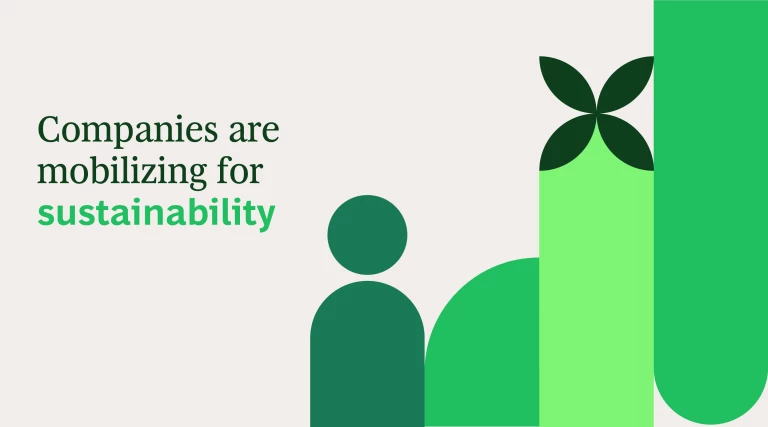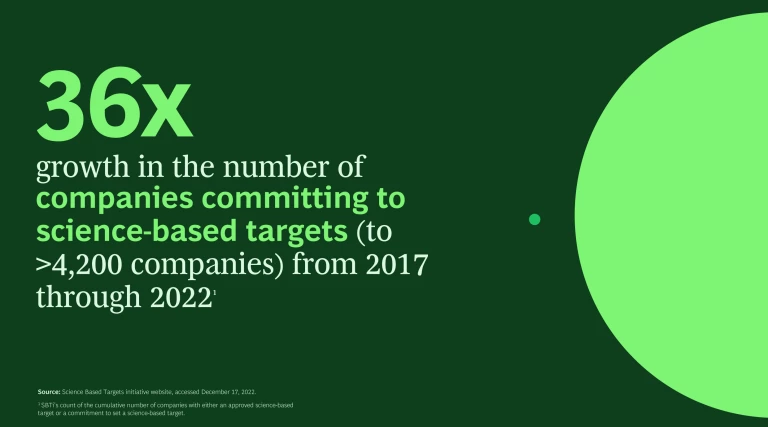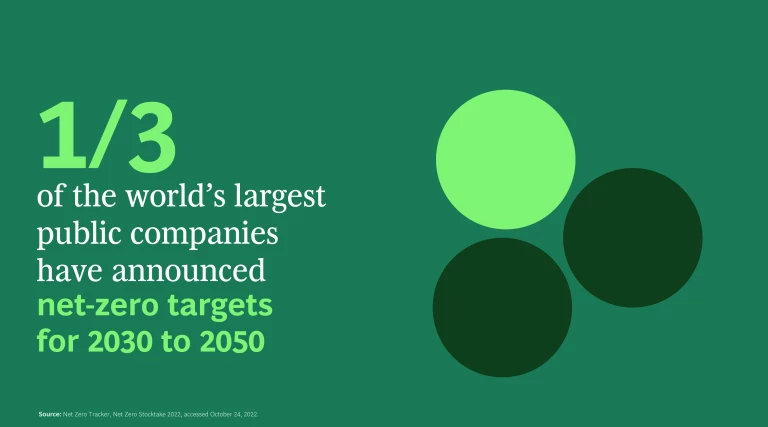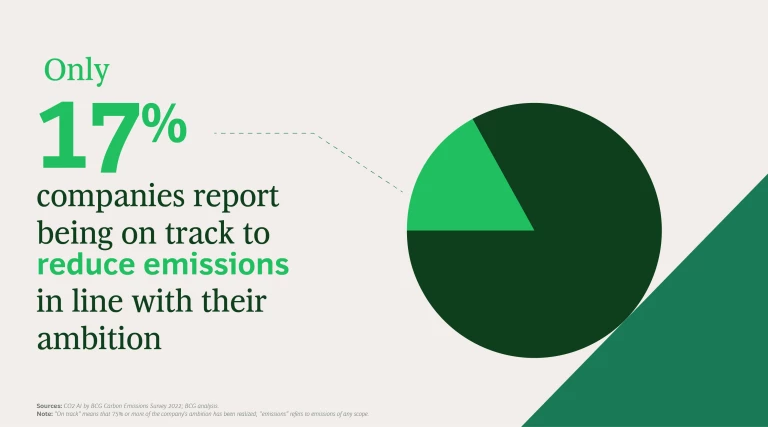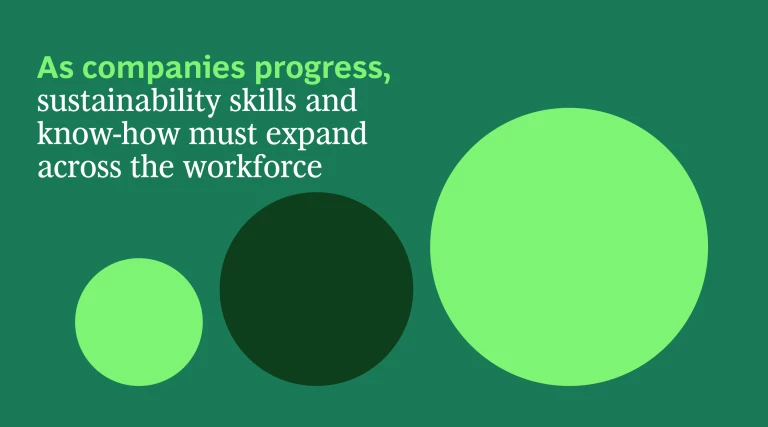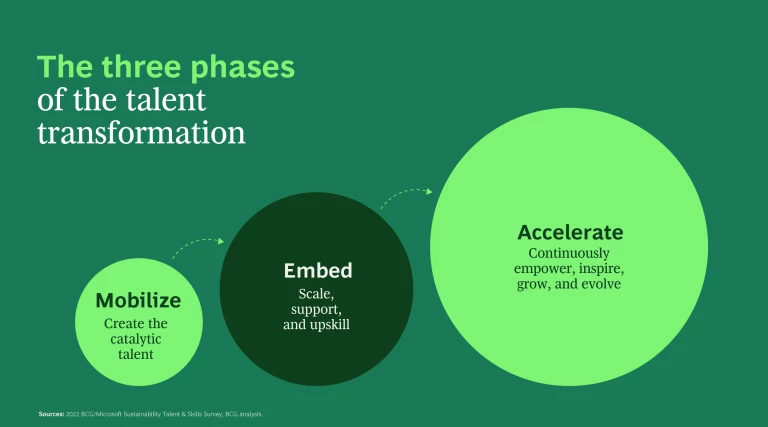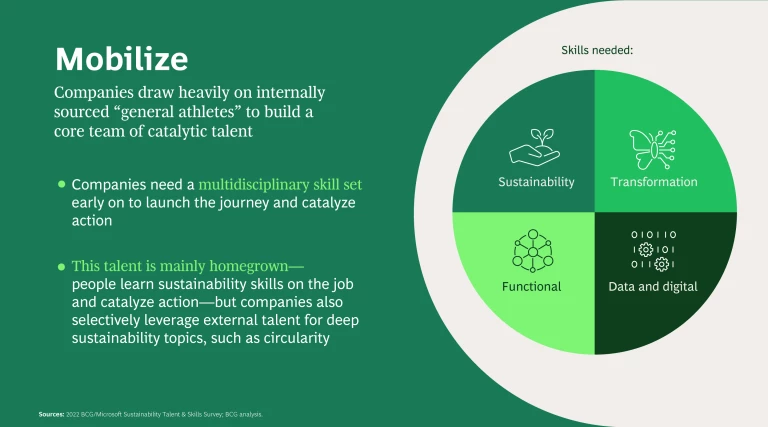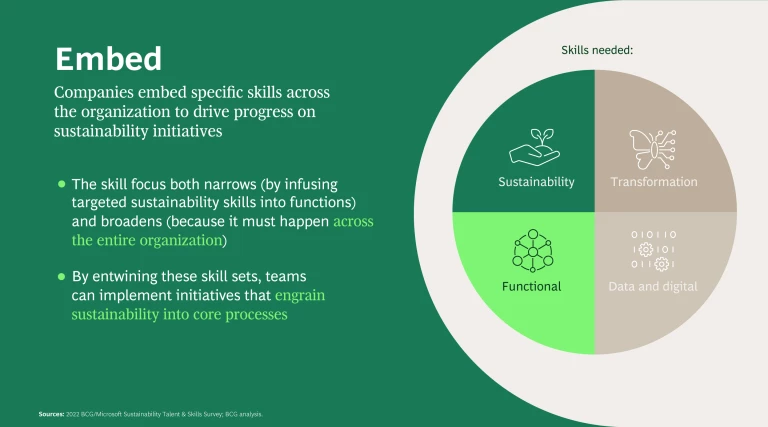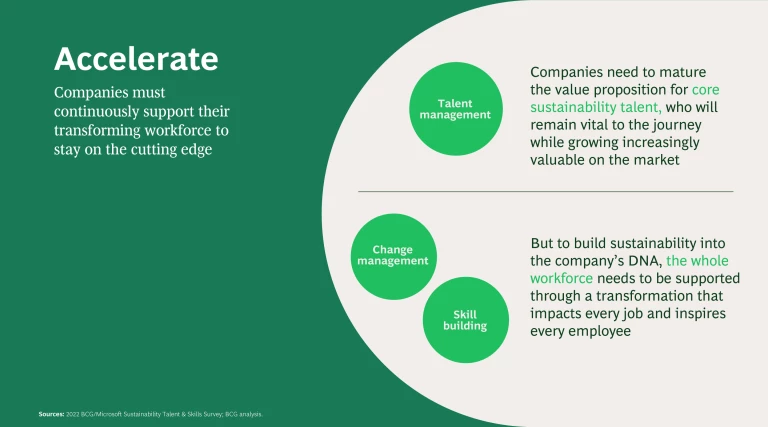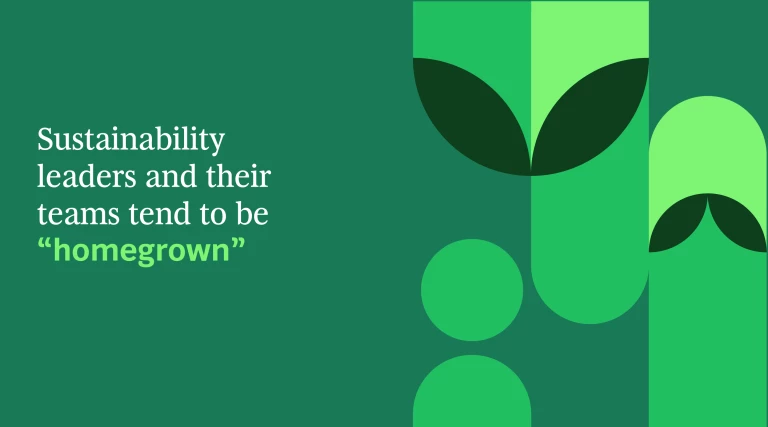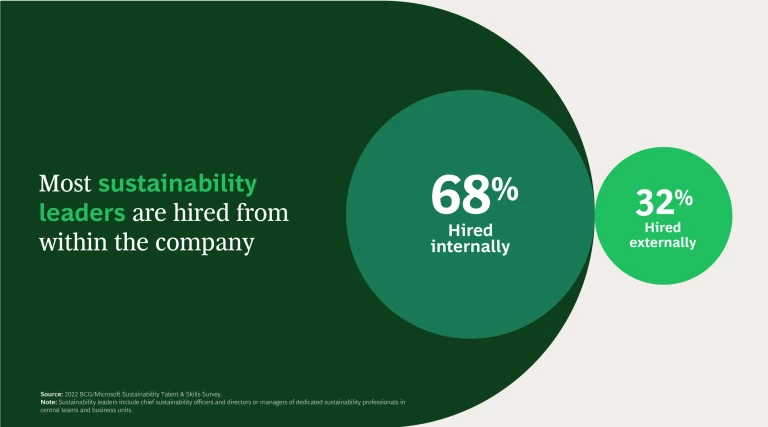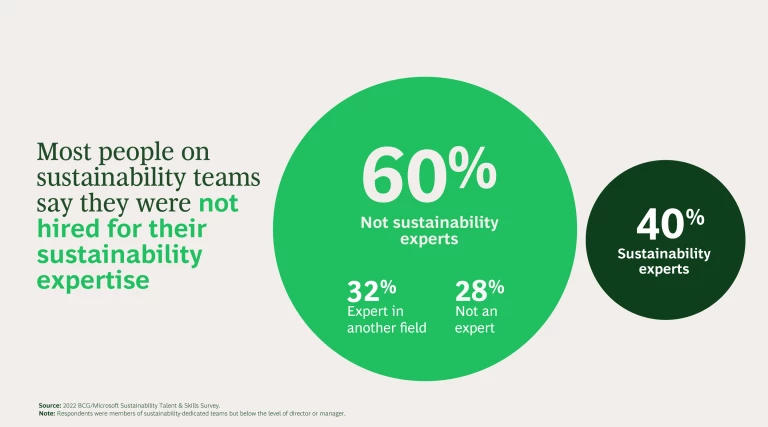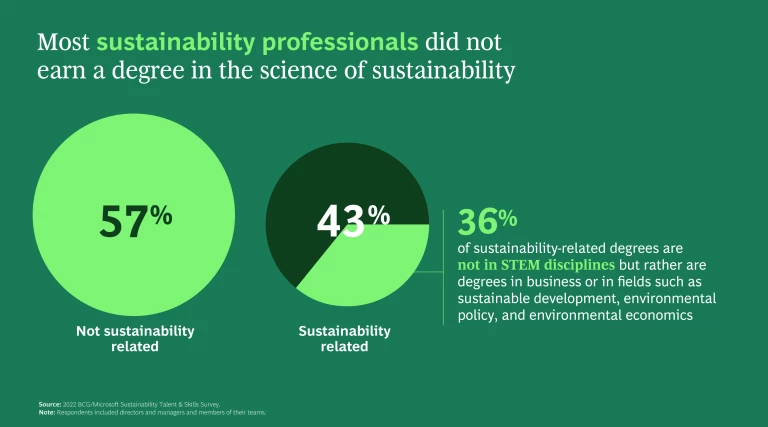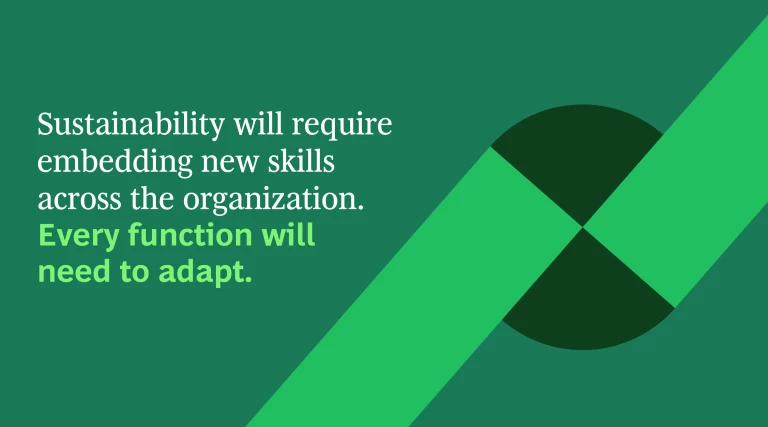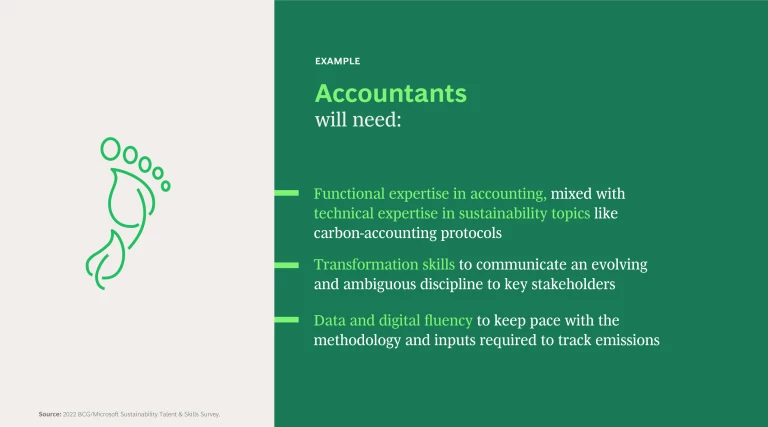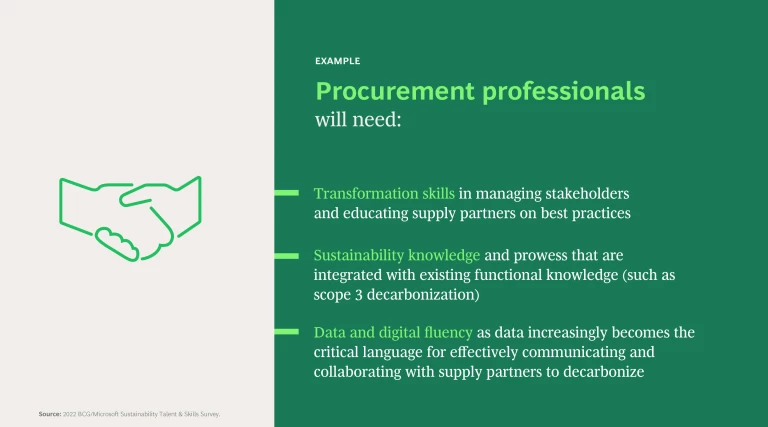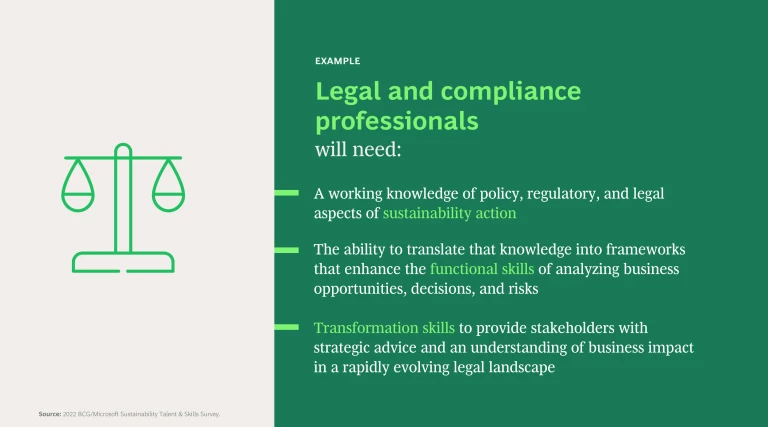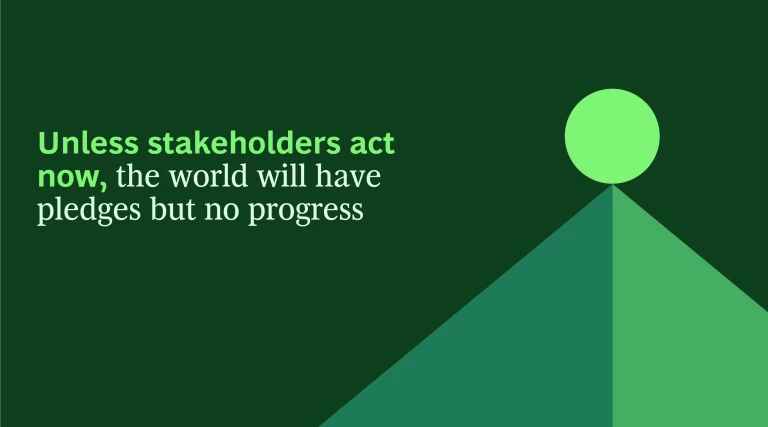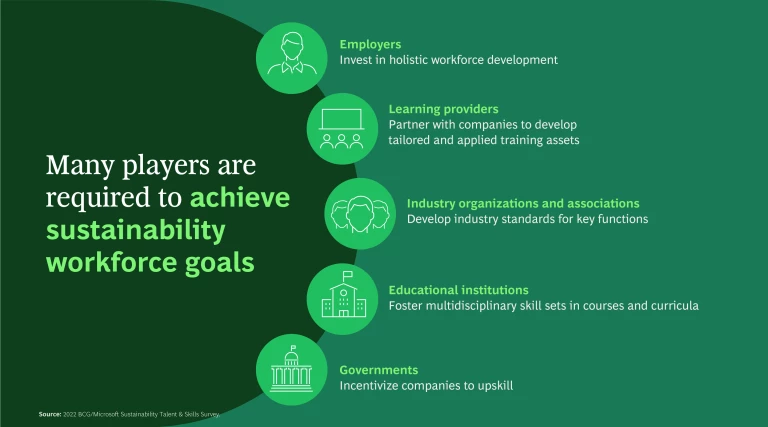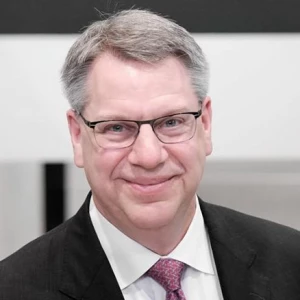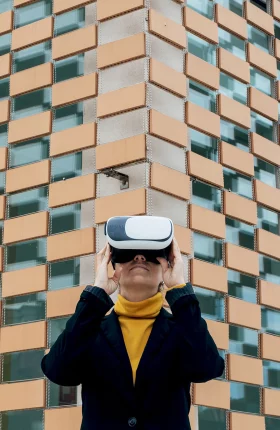Every company’s sustainability journey starts with a small group of talented leaders and individuals working on sustainability as a key strategic priority. But sustainability journeys—and the transition of the global economy—will succeed only when leaders and individuals throughout an organization have embraced sustainability as an inherent component of their everyday work. This means seamlessly incorporating it into business models and processes.
For any company, it’s a three-part journey:
Phase I: Mobilize.In the mobilize stage, companies rely on a small, central core of people within the organization to take the critical first steps in setting commitments and mobilizing stakeholders toward a clear strategy. “General athletes” prove to be some of the best equipped for the role: they have some (not deep) knowledge of sustainability, along with functional, transformation, and data and digital skills. This multidisciplinary skill set is necessary to drive change within the organization. These team members first and foremost know the organization well, and what they don’t know about sustainability, they learn. They can join together with a small number of more specialized experts to chart the course for change.
The fact that just 17% of companies are on track to meet their emissions targets reflects the enormous amount of work that is yet to be done to turn ambition into action—which points to a looming challenge: Do companies have the talent they need to pull it off? Turns out, it’s hard to acquire the expertise required to plan, let alone implement, sustainability transformations. According to LinkedIn, the number of job postings that include sustainability skills grew by 8% per year from 2016 through 2021, but the number of people with those skills increased by just 6% annually over that time period. Consequently, job searches that target sustainability experts often come up empty. The same is true when companies seek functional talent with fluency in key sustainability topics. “Procurement people with sustainability knowledge just don’t exist,” one executive we talked to explained.
The solution? His company now hires procurement people with no sustainability background and trains them in sustainability. Given the shortage of ready talent and the speed with which companies need to move, this “homegrown” talent approach is fueling many leading organizations’ journeys toward sustainability. Because the talent that will save nature doesn’t yet exist naturally (at least not in the quantities required), rapid upskilling has taken center stage.
This skill building is a massive undertaking. The need is acute, the scale is large, the timeline is tight, the right resources are scarce, and the learning curve is steep.
Understanding the Challenges
To better comprehend the talent landscape and the related challenges companies face when seeking to become sustainable, we conducted a research project, in partnership with Microsoft—a company that, like BCG, is pursuing its own ambitious sustainability objectives and seeking to help close systemic sustainability skills gaps. Together, we looked closely at 15 companies at the forefront of sustainability commitment—firms that have begun to confront the challenges and deploy solutions—and we surveyed and interviewed approximately 250 sustainability leaders and professionals there. (See “About Our Methodology,” and see Microsoft’s own insights and recommendations based on the research.)
Companies face three overarching challenges:
- The need to deploy sufficient talent with multidisciplinary, sustainability-related skill sets, which are hard to find in the precise combination required
- The need to embed new sustainability skills across the organization, which is not one challenge, but many—equivalent to the number of unique functions and business processes that make up an organization’s operations
- The need to act on each of these challenges with urgency, because the time to set and deliver on meaningful sustainability goals is now, and the task is big and growing
Multidisciplinary Skill Sets
Launching a sustainability journey calls for sustainability expertise, of course. But our research showed that companies recognize that expertise alone will not suffice. “We see that this is not a one-dimensional approach,” explained Owens Corning’s chief sustainability officer. “We have a very diverse background and team.” HSBC’s head of commercial banking sustainability concurred: “Think of it in terms of a rugby team,” he said. “All shapes, sizes, and skill sets.”
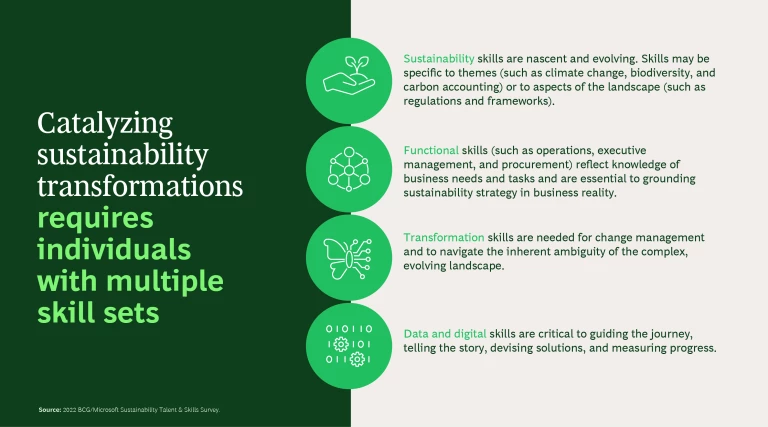
What are those skill sets? Our research revealed that teams need individuals with a mix of skills in four broad areas: sustainability, functional, transformation, and data and digital. In our survey, 84% of sustainability professionals said that the skills that are priorities in their jobs fall into at least two of those four broad dimensions.
When it comes to this skill profile, the emphasis need not even be on sustainability. In fact our research revealed, rather surprisingly, that it’s usually not. It’s the mix that matters, and the strongest starting point for that mix is usually found internally—hence the focus on internal talent and the challenge to upskill them to launch the sustainability journey.
Embeddedness
To continue their journey toward sustainability, companies will face the challenge of embedding skills across the entire organization. For most of the workforce, the focus will be on their blended sustainability and functional skills in the new “business as usual.”
Every function and every job within companies will need to adapt in ways that support the sustainability transformation. Product designers will need to learn to design for circularity, for instance, and logistics staff will have to know how to optimize routes, transport modes, and vendors to minimize the organization’s carbon footprint.
Further, embedding skills in this way will not be a blanket undertaking but rather will have to vary by job. Not only will companies need to embed new skills into nearly every job, they’ll have to customize the blend of skills and the ways tasks are carried out, functionally and sustainably, job by job.
Urgency
Decades ago, companies faced the early innings of a different kind of essential shift: digital transformation. To become digital organizations, they began by building digital fluency in small groups (organized as innovation labs or centers of excellence, for example) and then expanded that capability to embed it across the organization. Ultimately, they shifted to models designed to support and sustain digital fluency. (Many organizations are still on this digital transformation journey, which becomes a case in point.)
The sustainability journey for every company will be similar, unfolding in the same kind of three-phase approach: mobilize, embed, accelerate. And at an aggregate level the journey will be similar, too. Digital technologies—much like sustainable technologies—have been around for decades. But only in the past seven to ten years has there been an exponential acceleration in companies’ digital transformations. A similar or greater acceleration of sustainability transformations must take place, given many companies’ starting point in light of the huge goals that need to be achieved.
With crucial net-zero targets set for as soon as 2030, and the reality that broad swaths of the workforce will need to be enabled to meet those goals, companies have little time to achieve sustainability fluency.
The urgency challenge is clear and compelling. To meet their goals, organizations need to change the mindset and the skill set of every employee. They need to build multidisciplinary skill sets and embed them across the company. And they need to do it very quickly. The scale and speed required could mean upskilling some 150 million people globally in less than ten years—and that’s a conservative estimate.
Companies can’t wait for K–12 education to solve the talent problem. They can’t even wait for higher education to yield the necessary expertise, partly because of the exponential growth in the demand for this kind of talent and partly because seasoned talent is needed urgently. Companies must act now to marshal the talent needed for sustainability.
Meeting the Challenges
While our research showed that the challenges along the sustainability journey loom large, it also showed how sustainability front-runners are innovating to meet them. Companies just now embarking on a quest for sustainability talent can benefit from the insights that come from those first movers: a clear picture of just what they will need to start the journey, how they can build that talent, and how needs will evolve as things progress.
Early on, the focus should be on marshaling the required expert and sustainability-related resources for quick action. Then companies must build on those accomplishments to scale new capabilities across the organization. Finally, they must focus on preserving their hard-won sustainability capabilities. This means continuously expanding their workforce’s new abilities as part of business as usual; ensuring that their sustainability experts can chart long, lasting, and rich careers in their organizations; and deploying this now uniquely skilled workforce to create competitive advantage and enduring value.
When that happens, members of the workforce will continue to bring their crucial business and functional expertise (marketing, accounting, and customer service, for instance) to bear, but with the addition of critical sustainability skills and a sustainability mindset. In this new talent scenario—where the sustainability team is not a few dozen individuals but rather the wider organization—companies can turn sustainability goals into lasting competitive advantage and net-zero pledges into reality. This is a critical and increasingly common need, fueled by the large number of companies that are committing to reduce their emissions and their overall footprint.
Phase II: Embed. As they move forward, companies need broader sustainability fluency. Guided by the core team of general athletes and experts established in the mobilize stage, firms must embed sustainability skills across the organization in order to deliver on the sustainability initiatives within their business units and functions. Talent must still be multidisciplinary, but the emphasis should be on integrating the sustainability skills and the functional skills required to operate within the business units (sustainability skills plus procurement skills, for example, to achieve scope 3 reduction goals in the course of supplier relationship management). Depending on the job, the relative mix of the four skills will vary, but functional and sustainability skills will always be the bedrock.
Phase III: Accelerate. At this stage, sustainability is integrated across the full value chain, which means talent with sustainability capabilities is in place in every part of the organization. The company must shift its focus to supporting and maintaining its transformed talent. This will ensure retention and motivation for the few general athletes and experts who continue to play a catalyst role in the company’s sustainability agenda and engagement and accountability for the many who must own making sustainability come to life in their everyday work.
Phase I
In the first phase of building sustainability talent, companies will assemble their sustainability evangelists, who will not only make progress on sustainability but also show a wider population of employees how to embed sustainability into their roles, helping gain the buy-in of leaders and their teams from across the company and acting as agents of change for sustainability.
Mobilization phase team members deeply understand the company and its sustainability pledges. They have a sustainability mindset. They are quick learners and good communicators. In the words of one director of sustainability, members of the core mobilizing team have “the superpower of being able to interact and connect with people.”
That transformation skill is critical on a sustainability journey: For many companies, becoming more sustainable means fundamentally reinventing business models and operations—shifting from the ways value has historically been created and captured to something that may be materially different. That is no small change management feat, even when a company has the best of intentions to become sustainable.
Beyond those transformation superpowers, all sustainability-focused professionals, of course, need sustainability skills. They also require data and digital skills, for two reasons: Because they’ll need this language to communicate with organizational stakeholders about sustainability goals, and because they’ll spend a great deal of time measuring and demonstrating progress against those goals. And core sustainability-focused talent needs to operate from a functional understanding of how the organization works and how it creates and captures value.
What we found surprising is just how critical it is to have a balanced mix of sustainability, transformation, and data and digital skills, on top of the functional ones.
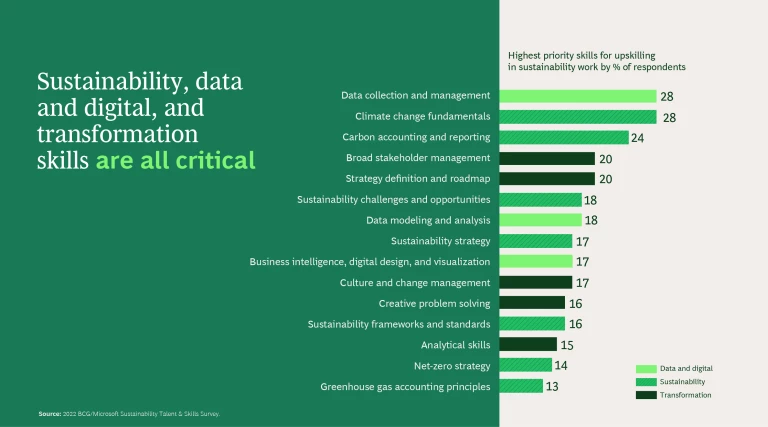
As a result, our research showed, front-runner companies are meeting the multidisciplinary skill set challenge by developing talent internally. They select employees with the necessary functional, transformation, and data and digital expertise to become members of the mobilization phase team and then help them rapidly gain sustainability expertise. (The reverse is harder to engineer. As Microsoft’s general manager for energy and renewables explained, “The challenge in finding really impactful people in this space is to find someone who’s focused very deeply on a particular aspect of the business before becoming a sustainability professional.”)
A snapshot of the backgrounds of the sustainability leaders and teams participating in our research shows how companies are assembling their sustainability talent, largely from inside the organization and primarily with a view toward developing sustainability skills on top of other attributes.
As these insiders step into their roles, they face a steep learning curve to upskill in sustainability—without enough of the proper solutions and resources at hand to do it. We asked members of sustainability teams to describe the upskilling challenges they have encountered. That the nascency of skills is far and away the prevailing challenge comes as no surprise, given how fast moving and dynamic the sustainability space is today.
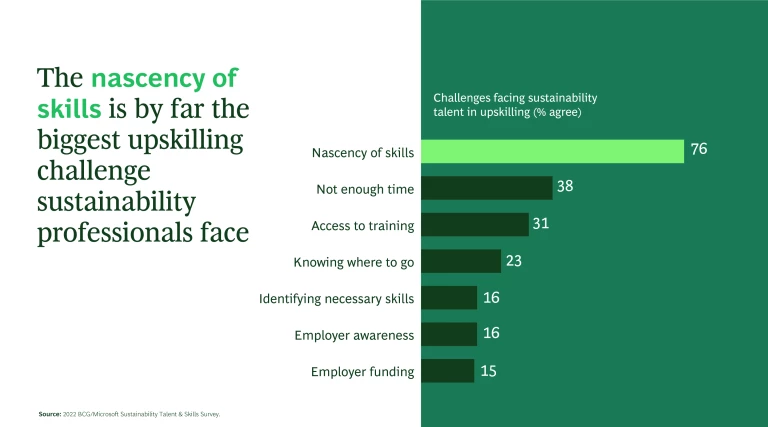
Because the required skills are so new, traditional means of acquiring them are insufficient at this point. In the meantime, on-the-job learning is critical—not only because other options aren’t yet mature and widely available but also because it is, by definition, designed to precisely meet a company’s unique needs. Rather than learning about sustainability in a classroom and then coming back to the workplace to figure out how to apply the knowledge, people can learn by doing, piece by piece—augmenting their knowledge as they go. At one industrial manufacturer, for example, upskilling tends to happen through scrappy methods. “We read books, we go to conferences, we stay on top of everything we can, however we can,” the company’s director of sustainability explained. Our research shows that short-term solutions like this, though not ideal, are helping companies progress on their sustainability journey.
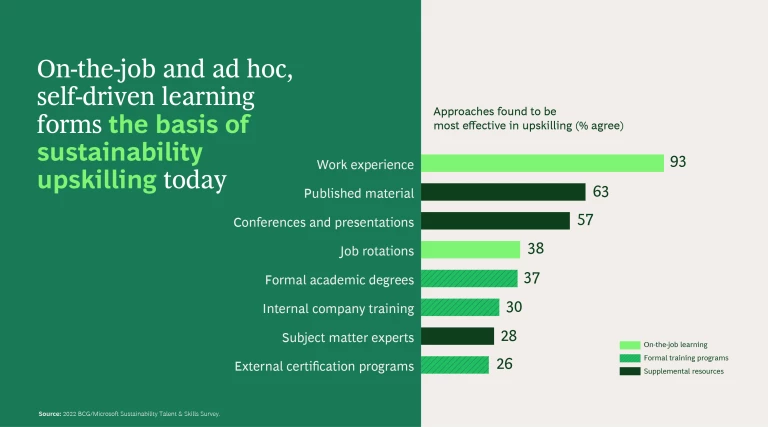
One recommended way to get the core team up and running, as mentioned, is to identify and activate the general athletes among the current workforce who can be upskilled to meet sustainability needs.
When leaders at one company were building their core team, for example, they struggled to find the necessary communication and people skills among external candidates. Looking internally, though, the company’s director of sustainability realized there were “gems sitting there in the organization” who also possessed valuable, hard-to-teach knowledge and an eagerness to learn and upskill.
AT&T is another company that has recognized the value of internal talent in filling sustainability roles. The people in the company’s business units “understand how all the aspects of sustainability can interact with the business operations, understand the business objectives, and know how to get things done in a complicated organization,” said the company’s chief sustainability officer.
Upskilling the internal team in these early days is easier when companies can rely on external learning providers. But it isn’t easy to find the needed external courses and certification programs. For instance, when we asked sustainability talent which upskilling methods they found most useful, only 26% included external certifications—the lowest among all methods cited. The 55 survey respondents who reported using external certification programs relied on 46 different certifications to gain the knowledge required in their roles, indicating the need to streamline and consolidate available resources. “There are so many good courses out there, it was actually quite hard to navigate,” said a BCG employee who rotated through the company’s sustainability team. He added that the course he ultimately found was useful.
Likewise, other training resources can be upgraded. Our research showed that companies are eager for external resources they can use to gain sustainability expertise.
Take HSBC. External training is common there—in fact, employees often turn to a single, university-offered course on sustainable finance, citing its specificity and applicability—but it’s also common knowledge that navigating available offerings is a maze. Organizations like HSBC recognize the value of partnering with external providers to improve training options.
While the merits of hiring internally are clear, companies also have the opportunity to augment their talent strategy with a plan to expand the core team through external hires, particularly when specialized or technical sustainability expertise is required. Companies report doing this early in the sustainability process for new requirements. Microsoft, for example, has hired externally to meet the need for carbon accountants. “We look for people who have managed carbon accounting at another company because it’s not always obvious how to do it if you haven’t already,” the company’s general manager of energy and resources explained.
Finally, outsourcing work as needed is a good way to get the journey started, with the ultimate goal of bringing the skills in house. Outsourcing helps transfer technical knowledge and build future capabilities to the internal team.
In the course of assessing its carbon footprint, BCG decided to augment its work by seeking an independent scientific opinion from an external partner. As the global sustainability lead at BCG explained, “Partnering with an external company brings assurance and comfort that you’re moving in the right direction.” This is a confidence that is essential as a company is building its own organizational muscle.
Phase II
In Phase II, the company’s core mobilization team of general athletes amplifies its efforts, turning strategy into reality by extending the blend of sustainability and functional skills, in particular, and embedding them into the daily work of the rest of the workforce. For the workforce at large, transformation and data and digital skills are not as imperative as they were for the general athletes who spearheaded the mobilize stage; rather, jobs will incorporate the four skills to varying degrees.
But driving embeddedness across the organization is no less a challenge than building the multidisciplinary team at the outset: Ultimately, almost every person in the organization will need to gain general sustainability fluency and merge their existing functional skills with the requisite new sustainability skills for their role. Exactly what that looks like will vary by job function—which explains why embeddedness is such a big challenge.
This marriage of sustainability and functional expertise proceeds according to company requirements: Where is it needed most urgently? The answer to that question will dictate which functions will be the first priority. Because food distribution company Sysco has determined that much of its scope 1 and 2 emissions come from its vehicles, for example, the company is prioritizing a switch to electric vehicles.
At this phase, the goal is to move from sustainability as a theoretical and strategic concept to “applied sustainability,” which requires that sustainability be embedded in nearly every job and reflected in nearly every job action. How do you tackle such a diverse, at-scale upskilling ambition?
Companies at Phase II can rely on several proven approaches. First, they can find ways to cascade learning and development throughout the organization and thereby build sustainability fluency.
HSBC provides one example. Its Sustainability Academy is a self-service training center that gives employees opportunities to learn about general sustainability topics as well as tailored content (by industry, for instance) and personalized educational pathways. HSBC trained several thousand client-facing employees on sustainability content in 2022 alone. Another example comes from JSW Steel, an Indian steel manufacturer. The company has focused on providing training opportunities (both classroom instruction and online modules) on fundamental sustainability topics. The concentration on sustainability training at JSW Steel has enabled the company to prioritize internal talent for sustainability roles, upskilling individuals on sustainability and leveraging existing functional expertise.
Another approach is to establish a center of excellence (CoE), where new sustainable business processes can be incubated until they are handed off to functions or business units. Further, the people working on those processes in the CoE can build the critical skills required to institutionalize them. As Owens Corning’s chief sustainability officer described the approach, “Solutions are so complex that we put an end-to-end team in the CoE. We won’t integrate until it becomes institutionalized, then we’ll move it into the business units.”
Owens Corning’s Ecodesign Strategy Wheel was developed this way. The Wheel is a business process that integrates sustainability objectives into the product design function. Designers must think up front about their products’ sustainability implications at each stage of the life cycle. Every new and modified product goes through a stewardship review process, which includes evaluation on sustainability criteria. The result: sustainability priorities were institutionalized in an important business process. It was, in the words of the company’s chief sustainability officer, “a massive shift.”
Sustainability pioneers will continue to encounter new skill needs—and must devise new skilling solutions. With that in mind, we urge companies to remain open to niche solutions for particular, targeted needs.
For instance, Sysco turned to an external industry association to help with one of its key sustainability initiatives: transitioning its fleet of trucks from diesel to electric. ACT Fleet Forum, an association of companies that are pursuing similar clean transportation solutions for fleets and that support one another by sharing best practices, helped in this effort. The association role has been critical, given the nascency of the field. The strategy has helped Sysco become a leader in this field. The company plans to expand its electric vehicle pilot in 2023, with a goal of converting 35% of its fleet to electric by 2030.
Phase III
In Phase III, companies must switch their operating focus to supporting and enabling their sustainability-capable workforce to turn sustainability into a competitive advantage. They must codify their new processes and approaches and thoughtfully and compassionately engage the workforce to maintain and excel in the new normal. Firms should also focus on retaining the sustainability expertise they’ve developed—and attracting more. As one company leader bluntly put it, “Everyone will want them.” It’s true. The age-old dilemma related to upskilling and reskilling applies here: What if I invest all this time and money in my people, and they leave, taking their newfound expertise to my competitors?
Prepare for today’s hiring frenzy to intensify. Organizations must protect their assets.
To help secure their experts, companies should continue to develop and educate those individuals, give them the opportunity to drive change, and offer them access to senior leadership. Inspire them. At the same time, be aware of impediments. As Microsoft’s senior program manager for Windows and devices sustainability put it, “A real challenge is that there is no sustainability career path. At some point, they’re going to want to grow in their function.”
Accordingly, companies at Phase III should plan proactively for career paths for sustainability-focused talent. They should create future roles and mobility opportunities for these individuals whenever possible. This not only helps to keep talent happy and growing, it also allows the company to purposefully design career mobility that strengthens its sustainability fabric. As people move within the organization, they cross-pollinate ideas and approaches. To help carve out career paths and growth opportunities, companies can look for candidates internally before searching externally, and managers can help employees find new internal roles. For example, HSBC offers a talent marketplace that lists openings so that employees can find new opportunities, including sustainability-focused ones.
Similarly, companies should continue to invest in continuing education. Sustainability won’t stand still. New technologies, regulations, and opportunities will emerge, and talent will need to keep gaining skills and capabilities. Accordingly, L&D functions must be nimble in designing and launching learning solutions. Continued upskilling will be valuable to the organization and serve as an employee benefit and an avenue to growth.
For example, BCG has augmented its internally focused Climate and Sustainability Academy with partnerships that offer employees the opportunity to enroll in intensive courses at Cambridge Judge Business School and Columbia Climate School. Similar efforts will be particularly useful at Phase III.
Companies should also focus on culture change. To make sustainability an intrinsic part of everyday work and the company’s focus, culture must be transformed to emphasize the new sustainable businesses and ways of working.
Owens Corning’s handprint/footprint approach to building sustainability into its business processes is an example of the kind of culture change companies should pursue at Phase III. “Footprint” is a familiar term—it reflects the negative impact of a product’s manufacturing process on water consumption and greenhouse gas emissions. The “handprint,” though, refers to the positive impact a product can have throughout the value chain, including content that can be recycled, end-of-life solutions, circularity, transparency on raw materials sourcing, and the reduction of supplier emissions. These principles represent core objectives, and the company has integrated them into its business processes.
The handprint/footprint approach has a further benefit: creating an inspiring company culture that emphasizes sustainability. People across Owens Corning, no matter their role, are able to celebrate their ability not just to mitigate the negative footprint but also to enact positive outcomes in the form of a positive handprint impact—and leave a real mark they can feel proud of. That’s what embedding a successful sustainability mindset looks like. “As we developed our priorities, we started looking at sustainability through a holistic lens,” the company’s chief sustainability officer explained. “It’s about improving people’s quality of life.”
Unilever, the consumer goods giant, offers another example. The company, which has so far achieved a 64% reduction in its scope 1 and 2 emissions since 2015, began its sustainability transformation in 2010 with its Sustainable Living Plan, which ran for a decade. Now the company is taking a different approach by embedding sustainability into its business strategy and company culture through its Compass goals program.
“The Compass goals are embedded into the heart of what we do,” said the company’s director of technology, innovation, and sustainability. “I wouldn’t see it as training. It’s more of a culture thing. This is our North Star of where we’re going.” In fact, some of the company’s most experienced experts don’t think of themselves as “sustainability talent,” and their titles and job descriptions don’t mention sustainability. Nonetheless, they apply that lens to the teams they’re on and drive progress in the company’s sustainability objectives.
Microsoft, too, has seen success in integrating sustainability with business processes, through its approach to internal carbon pricing. In January 2020, when it decided to include scope 3 emissions in its internal carbon tax, a much broader segment of the company suddenly became concerned about emissions and sustainability. Previously, the internal carbon tax had been in place for years but applied only to scope 1 and 2 emissions and thus affected a relatively small portion of the company. Once the scope 3 inclusion was made, “a lot more people had to start thinking about emissions,” the company’s head of renewable energy for cloud explained.
This policy change resulted in the creation of many more sustainability teams throughout the organization, illustrating the potential for internal initiatives to spark wider sustainability objectives.
One industrial manufacturer’s sustainability transformation involved a strategic shift, from a focus on products to a focus on customers—more specifically, on helping customers make their production systems sustainable. Such a sweeping change in strategy required a shift in mindset and companywide buy-in. “Here’s what we need to do” or “here’s where we’re headed” were not messages that would galvanize the transformation. Rather, the company inspired its employees and customers by addressing the importance of their work.
The launch of the new campaign generated excitement among the workforce. “Inspirational vision. Revolutionary journey—excited to be a part of this,” commented one person. Said another: “Proud and excited to be part of this journey!”
The Sustainable Advantage: Build lasting impact through sustainability
A call to action
The upskilling challenge is daunting. Companies are doing what they can with the solutions that exist. But to meet the rapidly growing, increasingly urgent worldwide demand for sustainability talent a variety of players must take action.
Leading companies’ experiences with upskilling show us that if we are truly going to turn pledges into progress—and do so at the unprecedented scale and pace that is required to transform our global economy for sustainability—we need near- and long-term solutions.
Right now, we must find ways to make the employer-led upskilling of existing workforces easier, faster, and more impactful. Employers are increasingly investing in holistic workforce development—from the small groups of people who mobilize the sustainability journey with their multidisciplinary skill sets (the general athletes) to the thousands of functional workers in each organization who need new skills and know-how to embed sustainability into their roles. There’s no reason why employers should tackle this gargantuan task alone. Help is on the way. For example, the professionals at the companies we researched easily found sustainability learning options. The problem was choosing the right one. Often, the content was too plentiful to sift through, too theoretical or high-level to be applicable, or too in-depth to reasonably digest before putting it into action. But solutions can be developed.
Learning providers can work with employers to create rich, easy-to-access sustainability learning solutions that get to the heart of business professionals’ needs.
Similarly, industry associations and other functional standard-setting organizations can play an important role. These trusted entities can highlight the best learning opportunities for their constituents by codeveloping courses that credibly upskill professionals in exactly what they need to know. Also, they can curate and certify existing resources to help learners find what they need. They can link branded certifications and credentials to the completion of these programs, which can then become clear indicators of industry-recognized and endorsed skill sets.
Longer term, the educational system must reimagine learning at all levels so that talent emerges from school ready, willing, and able to contribute to an economic system that has sustainability management at the core and sustainable development as the goal. Even the youngest learners can start developing sustainability fluency and data and digital skills as part of core K–12 curricula, preparing them to understand the transitioning economy, speak the language of sustainability, and engage in science-guided thinking. Sustainability-related competencies will become increasingly important as learners advance in their education. At the advanced-degree end of the spectrum, learning experiences will need to weave together sustainability and business concepts to deftly navigate the new reality of creating value and competitive advantage for companies while protecting and contributing to a sustainable future for all.
Governments will be essential catalysts in the near and longer term. They can spearhead efforts to create common sustainability skill taxonomies and job architecture as a framework for targeted solution development, incentivize the creation of widely available learning resources and solutions, and form public-private partnerships to enhance learning solutions, forums, and opportunities. And as our partners at Microsoft outlined in detail in their report, as much needs to be done to prepare the workforce of the future to take on tomorrow’s sustainability challenges as is required to prepare the workforce of today. Governments will play a critical convening role on that longer-term time horizon, too—recognizing that we are still in the early stages of this vast economic transformation.
Imagine a world where sustainability is so embedded in day-to-day work that sustainability labels are no longer needed. Accounting practices will include accounting for greenhouse gas emissions, and all related staff will be fully versed in the latest protocols and methods. Product design will include designing for end of life and promoting a circular economy, with all designers adhering to that standard.
From our many conversations throughout this research, the story is clear: There is a path for companies to achieve that level of embeddedness. A thoughtful approach to building and supporting talent is essential to success. It will be a herculean undertaking to drive this scale of talent transformation across our economy on a compressed timeline. We need more and better talent development solutions than we have today.
This talent undertaking must be a collective effort. Already we see that corporate sustainability leaders are sharing what they’ve learned to benefit the greater good. They understand that it’s imperative to inform those who will embark on the same talent journey. And they know those organizations could likewise develop solutions to improve the journey for all.
It is our hope that this kind of collaboration will help us write the next chapter of this story and mobilize today’s workforce for a sustainable future.
The authors thank the company leaders and sustainability professionals who participated in the development of this report through interviews and surveys. Among the companies we worked with: AT&T, HSBC, John Deere, JSW Steel, Owens Corning, Sysco, and Unilever.
The authors also acknowledge the significant contributions of our partners at Microsoft.
Thanks as well to our BCG colleagues who contributed to this research: Nick Intscher, Anjuli Eidsness, Hong Tran, Carolyne Makumi, and Nicky Axmann.
Methodology
- The critical skill sets and experiences necessary to drive the sustainability agenda
- Strategies for acquiring and developing talent throughout the organization as sustainability efforts scale
- Ways to turbocharge the sustainability journey by instilling the right skills and mindset throughout the company
- AT&T
- HSBC
- John Deere
- JSW Steel
- Owens Corning
- Sysco
- Unilever





